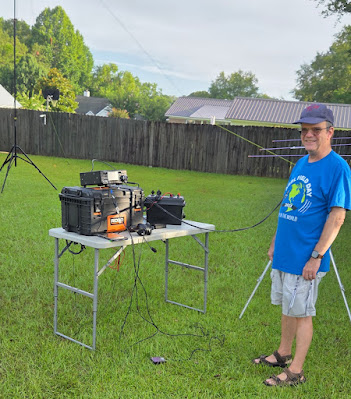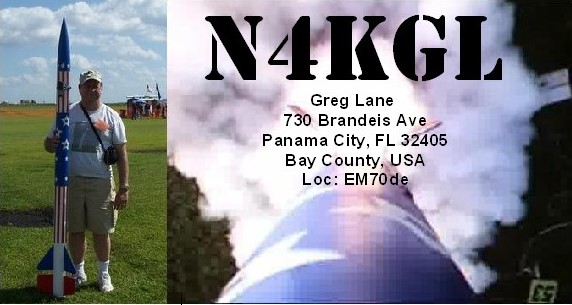Monday, November 10, 2025
N4KGL RaDAR Rally Nov 2025
Tuesday, September 23, 2025
Flight of the Bumblebees with the Elecraft KH1
Thursday, September 11, 2025
Ways to do RaDAR
Sunday, July 6, 2025
N4KGL's 2025 ARRL QRP Field Day
Rick NZ2I and I teamed up for a two-operator, two-transmitter Bravo battery category entry for the June 2025 ARRL Field Day. The battery entry has a power multiplier of five. Rick operated digital FT8/FT4, and I used CW. Those modes are two points each, which nets 10 points with the power multiplier. We skipped phone contacts since they are more challenging than the other two modes, and they net half the points.
 |
| The BuddiHex hex beam is always a winner for Field Day |
Our venue changed this year; we operated from my camping trailer, which was parked at my daughter's house in Dothan, Alabama. Operating inside the trailer had the advantage of air conditioning. Fortunately, the backyard had enough room for our antennas, the Buddihex Hex beam for 20, 15, 10, and 6 meters, and a link dipole for 80 and 40 meters. I used the Icom 705 for CW, and Rick used the Icom 7100 for digital. We used a Quadplexer box with band filters to utilize the hex beam on two bands simultaneously.
 |
| I used the Icom 705 in the foreground for CW. Rick used the Icom 7100 for digital. |
There was a thunderstorm with lightning on Saturday afternoon for an hour. The winds picked up, and a guy cord came loose on the hex beam. The mast was flexing, so we lowered the beam for a while, after the storm, then raised it again. We had a good hour at 4 p.m. and broke for supper at five. After supper, we operated until 10 p.m.
 |
| Rick pointed the Arrow antenna. The rig was an Icom 9700, and a S.A.T. box was used to handle the Doppler. |
On Sunday morning, I was able to work K4BFT, the Huntsville club, on the RS-44 satellite with Rick's assistance. I also got a Winlink message sent to the Section Manager. Friday Night, I was able to copy the Field Day Bulletin using PSK-31 on 40 meters. These together were three hundred bonus points.
 |
| Our hourly contacts. |
We put in a strong finish, thanks to the bands' cooperation on Sunday. We aimed to surpass the 350 contacts from last year. We beat by seven contacts. Rick got more FT4 than FT8 contacts this year. Note that during the final hour, Rick's FT4 and my hunt-and-pounce CW had the same rate.
 |
| Suzy had first dibs on the couch. |
We had no problem making contacts with QRP power, five watts or less. Score-wise, we were gaining six more points per contact than we would have had by operating at 100 watts. Our plan came together, and we felt we had a great ARRL Field Day once again.
73,
Greg N4KGL and Rick NZ2I
Wednesday, April 23, 2025
RaDAR, SOTA, POTA and Dinosaurs at Stone Mountain Park, Georgia
Linda, Suzy, and I camped at Stone Mountain Park the first week of April 2025.
The mountain offers a Summits on the Air (SOTA) opportunity. Walking up the mountain was tempting, but I rode the Sky Tram instead. I took the Icom 705 and the Alexloop. I found the winds gusty on top, and they blew the loop tripod over. I managed to tie it down with a cord and my foot. I have more than enough contacts for SOTA and POTA, including 2-meter FM contacts as far as fifty miles.
The RaDAR Rally was on April 5th. I had many options among the park trails, but I settled on taking my one-kilometer walks from our campsite. My rig was the FX-4C, and the antenna was the SOTABeams link dipole. I made five contacts on three stops, setting up the dipole each time. The Alexloop would have been faster. My contacts included CW, SSB, and FT-8. The FT8CN Android App on my smartphone connects to the FX-4CR via Bluetooth. The highlight was a RaDAR-to-RaDAR contact with Chris, VA3ECO. Chris was using a snowmobile for his RaDAR.
Linda and I enjoyed the attractions in the park. It was Dinofest. We took in the drone, laser, and fireworks show on our last night.
73,
Greg N4KGL





